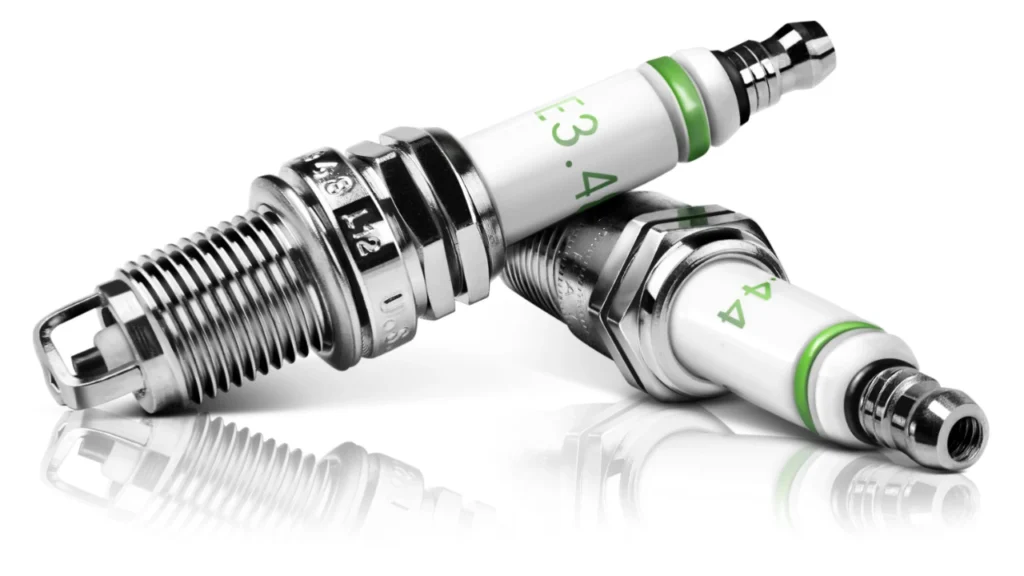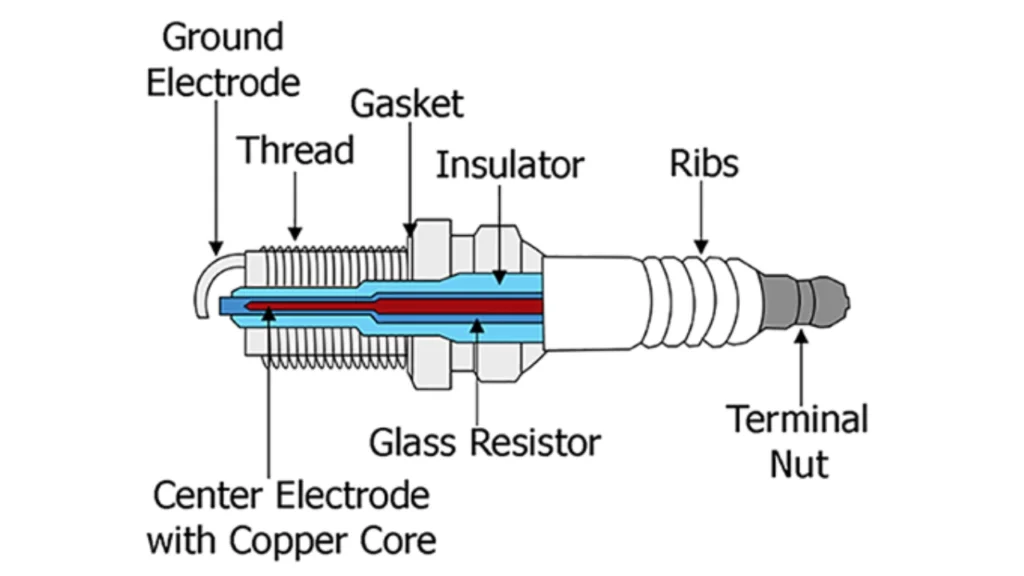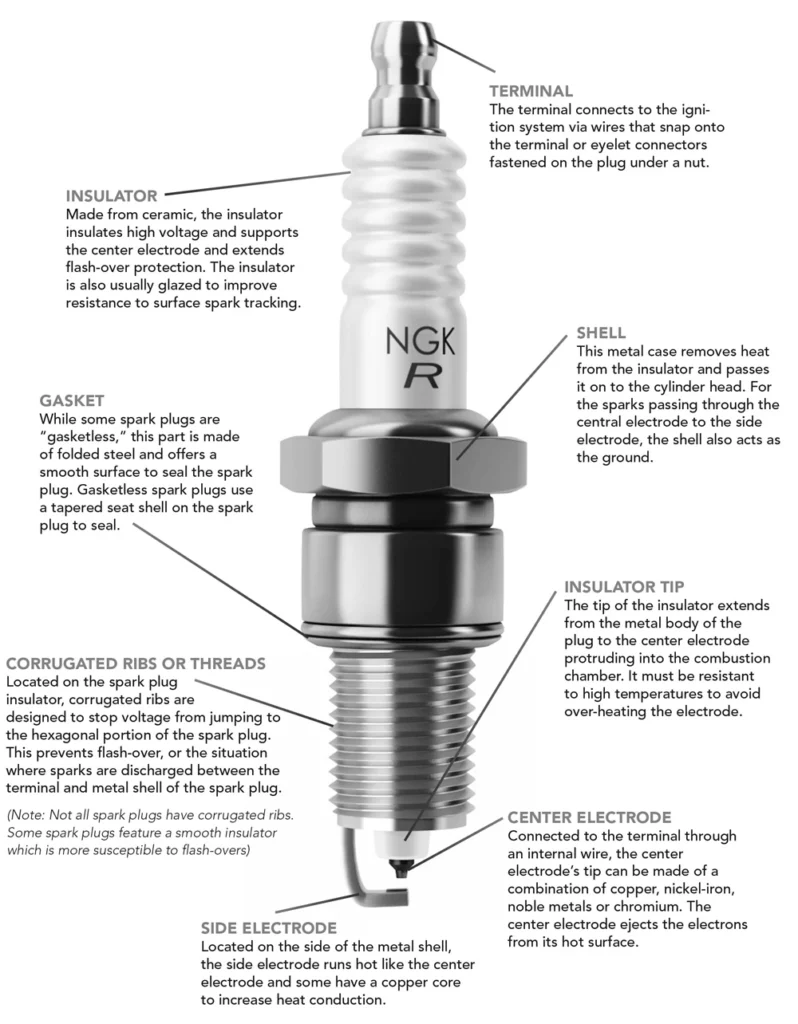The spark plug is a seemingly simple device, although it is tasked with a couple of different but critical jobs. First and foremost, it creates (literally) an artificial bolt of lightning within the combustion chamber (cylinder head) of the engine.
The electrical energy (voltage) it transmits is extremely high in order to create a spark and to “light the fire” within the controlled chaos of the combustion chamber. Here, the voltage at the spark plug can be anywhere from 20,000 to more than 100,000 voltages.
What is a Spark plug?
A Spark Plug also called a Sparking Plug, device that fits into the cylinder head of an internal-combustion engine and carries two electrodes separated by an air gap, across which current from a high-tension ignition system discharge, forms a spark for igniting the air–fuel mixture.
The electrodes must be able to resist high temperatures, and the insulator separating them must withstand high temperatures and electric stress up to several thousand volts.
Spark-gap length affects the energy of the spark, and the shape of the insulator affects the temperature of the operation. When too cool, operation leads to carbonization and short-circuiting of the gap; when too hot, there may be preignition.

How Do Spark Plugs Work?
Think of spark plugs as the tiniest bolt of lightning. Small but mighty, they spark electricity that ignites an air-fuel mixture deep within your car’s engine. In turn, combustion creates the energy required to power your car’s pistons, and ultimately, get you to your destination.
These components also play an important role in helping to dissipate heat from the combustion chamber to the engine’s cooling system. Here’s the step-by-step:
Step 1: You turn the key in the ignition.
When you start your car by pushing the “ignition button” or inserting and turning your key, the starter motor engages, which cranks your engine.
Step 2: Energy from the battery ignites the plugs.
Electricity from the battery travels to an induction coil on your car’s combustion engine, which transforms the battery’s 12 volts to as much as 45,000 volts before supplying it to the spark plugs.
Step 3: Sparks fly.
As the induction coil’s voltage increases and is transferred to the spark plugs, the plugs ignite the air-fuel mixture inside the combustion chamber — generating a small and controlled explosion in the gap between the plug’s electrodes.
Step 4: Combustion moves your car.
Once the air-fuel mixture ignites, a chemical reaction occurs, turning the mixture into an expanded gas or exhaust. The pressure generated by this sudden expansion within the combustion chamber moves your car’s pistons, ultimately turning chemical energy into the kinetic energy required to power the engine.
Step 5: The cycle continues.
As you continue your journey, the spark plugs power through this cycle repeatedly, helping your car run smoothly till you reach your destination.
Spark Plug Diagram
The diagram of the spark plug hasn’t changed much since the inception of the combustion engine in the late 1800s. A central electrode that carries the current runs the entire length of the spark plug. The spark plug wires (if applicable – older technology) or the ignition coil connected to the top of the spark plug electrode. A ceramic insulator separates the electrode from the rest of the spark plug.

The plug is screwed into the cylinder head and protrudes into the combustion chamber with a threaded metal section, called the ground point of the spark plug. At the bottom of the spark plug is a small metal piece that looks like a “J” sitting sideways – this is the side (or ground) electrode. There is a gap between the center electrode and the side (ground) electrode, which is where the spark jumps the gap.
Read More: How to Gap Spark Plugs?
Spark Plug Construction
A spark plug comprises three main parts: the housing, insulator, and electrodes.

- Terminal. Connects to the ignition system and conducts the high voltage to the central electrode.
- Insulator. Insulates the terminal, center shaft and center electrode against high voltage and provides flashover protection. Keeps high voltage from escaping before it gets to the electrode tip.
- Resistor. Suppresses ignition noise that is generated during sparking. Helps prevent electrical interference with other electrical components in the vehicle and disruption to radio reception.
- Central Electrode. Connects to the terminal by an internal wire. Tip is made of copper, nickel, chromium, or other precious metals. The metal carries the high voltage through the spark plug so it can spark when it goes across the small gap between the central electrode and the side electrode.
- Ground or Side Electrode. Located on the side of the metal, it extends into the combustion chamber to create the spark that ignites the fuel.
- Hex Head. Steel shell where a socket wrench fits for tightening and loosening the plug. Provides electrical ground to cylinder head and transfers heat to the head to help cool the plug.
- Gasket. Located between the insulator and the housing, it helps keep combustion gases from escaping.
- Ribs. Helps stop voltage from jumping to the hex head.
Different Types of Spark Plugs
Spark Plugs can be put into two different primary classifications, based on their operating temperatures, and based on their construction.
Based on Operating Temperatures
Once the combustion process is completed in the combustion cycle, the heat generated needs to dissipate. The heat escapes through the exhaust gases, the cylinder wall of the engine, and the spark plug surface. Based on the operating temperature and level of heat dissipation, spark plugs can be classified into two types:
- Hot Spark Plug: A hot spark plug operates in a higher temperature range. It has a lesser ceramic area which is used to insulate the heat. A hot spark plug dissipates lesser combustion heat and allows the tip and electrode to stay hotter. This ensures that any deposit accumulation is burned off and isn’t allowed to stay for long.
- Cold Spark Plug: For high-performance engines that run hot by default, using a hot spark plug will cause pre-ignition. In extreme cases, it can also lead to the tip melting off. In such cases, a cold spark plug is used. Here the ceramic insulation area is higher, which will dissipate more heat. But on the flip side, it is prone to greater deposit accumulation. Be sure to follow your instruction manual and use the correct type of plug recommended for your engine for optimum performance.
Based on the Material Used
Spark Plugs are further classified based on the material used on the ends of the electrodes. They are of 4 types:
1. Copper Spark Plugs
The copper spark plug is the most used spark plug as it is the cheapest among the three. In copper spark plugs the outer material used is nickel alloy which wears down easily because of the high pressure and the high heat generated in the cylinder of the engine. This wear results in the fouling of the spark plugs because of this they have a short life span.
2. Platinum Spark Plugs
Platinum spark plugs generally have a platinum disc on the end of the electrode tip, which preserves the electrode edge with its higher melting point (3,218º F). These spark plugs allow for longer use, usually 30-40 thousand miles, and run a bit hotter than copper, which prevents fouling.
3. Iridium Spark Plugs
Iridium has a higher melting point, and it is stronger than platinum which provides it superior wear characteristics. Also, iridium spark plugs feature a thin wire center electrode which conducts electrical energy better and increases the firing efficiency.
Because of all these qualities, the life span of iridium spark plugs are more than platinum spark plugs.
4. Ruthenium spark plugs
This is one of the newest precious metals to be used in spark plugs. They claim improved durability over iridium but carry a higher price tag.
5. Silver spark plugs
These plugs feature silver-coated electrodes and may be seen in some performance applications. They aren’t very common, since they are costly yet not as durable as platinum or iridium.
What Causes Spark Plugs to Go Bad?
The last bit of info we’ll leave drivers with is what causes spark plugs to go bad. Are there ways drivers can avoid wear and tear on their spark plugs? The most common problem with spark plugs is the build of oil and carbon that dulls their effectiveness.
Now, some of this is unavoidable and the natural course of a vehicle’s life, but things like the overheating of spark plugs from an incorrect fuel-to-air ratio can wear out spark plugs faster. Other factors for accelerated spark plug degradation include poor fuel quality and a bad fuel filter that can lead to a carbon build-up.
Another thing for drivers to look out for when their spark plugs are causing problems is a loose wire connection from low-quality plugs or improper engine tuning. Drivers should keep an eye on these things to help prolong the use and life of their spark plugs.
Benefits of Changing Spark Plugs
Service intervals vary, with most manufacturers recommending spark plug replacement between 60,000 and 100,000 miles on late-model vehicles. Specific application and vehicle usage will need to be considered as well.
When spark plugs are replaced, you’ll likely notice some of the following benefits:
- Improved power, increased fuel economy, and reduced emissions: These three issues are a direct result of spark plug efficiency. A plug that fires efficiently will help keep things in check.
- Smooth running: Whether it be starting, accelerating or cruising, a properly performing spark plug keeps things running just right.
- Reduced risk of catalytic converter failure: Misfiring of spark plugs can cause unburned fuel to collect and overheat in the exhaust, which has the potential to damage the catalytic converter. If a failure is left unresolved, this can get expensive.